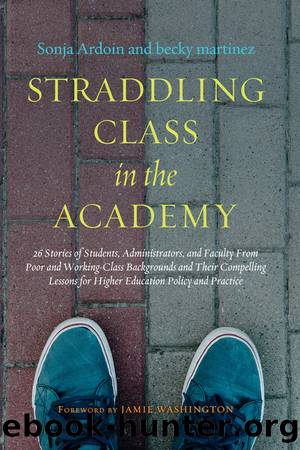Straddling Class in the Academy by Sonja Ardoin

Author:Sonja Ardoin
Language: eng
Format: epub
Publisher: Stylus Publishing
Narrative Analysis
As we take in these three individualsâ stories, we should first note that, although they may be few in number, some senior administrators in the academy come from poor and working-class backgrounds. So, if you are reading this as someone who shares that background and aspires to serve in a similar capacity, know that is possible; and if you are reading this from a different lens, know that the senior administrator on your campus may take actions you donât quite understand because their social class worldview differs from yours.
Our senior administrators describe for us some of their childhood experiences and then offer insights on how that upbringing melds into their present-day roles. All of them share the multitude of influences that taught them about their social class, noting family as the most prominent instructors. Although they hold different racial and ethnic identities, Mamta and Jeremiah both name the bootstrap theory that was present in their households and communities, the belief that it is up to individuals to work hard enough to alter their own circumstances and the disregard for any systemic barriers that might hamper that. Thomas mentions his own parentsâ work ethic, holding multiple jobs at once, and talks about food as a symbol of social class in his household, utilizing coupons and making the most of leftovers. Jeremiah also examines how location and school rank, even at the preKâ12 level, can impact oneâs social and cultural capital and, correspondingly, how a student is perceived by peers, teachers, and administrators.
Mamta, Thomas, and Jeremiah discuss how these values and messages from their backgrounds manifest in their perceptions of higher education and their roles as senior administrators. Jeremiah offers his dual pride in his upbringing and the people involved in it and in his opportunities to grow through education but notes that, despite acquiring some middle-class ways and preferences, imposter syndrome can consistently lie below the surface. Mamta describes how she notices her social class background influencing her feelings and decisions around divisional budgeting and resource allocation. Similarly, Thomas explains the awkwardness that can arise at donor and fund raising events because of differing social class worldviews and types of navigational capital. Mamta also acknowledges the vulnerability it takes to talk about social class, particularly when someone experiences a clash between their class of origin and their current, or attributed class, or both. This complexity of identity and context can instill feelings of fear and guilt, both of which Mamta describes. Additionally, all three administrators reference other dimensions of their identities that interact with their social classânamely, race, culture, and gender. This highlights, yet again, that social class is not experienced in isolation and, thus, is influenced by and through its combination with other aspects of our identity.
The three individuals explore how the academy doesâor does notâserve students from poor and working-class backgrounds. Thomas points out an array of barriers we create between students and their academic and cocurricular engagement, including time, costs, financial aid policies, and the conflation of racial and class identities that often results in inaccurate and harmful assumptions about students.
Download
This site does not store any files on its server. We only index and link to content provided by other sites. Please contact the content providers to delete copyright contents if any and email us, we'll remove relevant links or contents immediately.
The Art of Coaching Workbook by Elena Aguilar(50977)
Trainspotting by Irvine Welsh(21518)
Twilight of the Idols With the Antichrist and Ecce Homo by Friedrich Nietzsche(18501)
Fangirl by Rainbow Rowell(9095)
Periodization Training for Sports by Tudor Bompa(8168)
Change Your Questions, Change Your Life by Marilee Adams(7634)
This Is How You Lose Her by Junot Diaz(6788)
Asking the Right Questions: A Guide to Critical Thinking by M. Neil Browne & Stuart M. Keeley(5632)
Grit by Angela Duckworth(5514)
Red Sparrow by Jason Matthews(5390)
Paper Towns by Green John(5087)
Room 212 by Kate Stewart(5035)
Ken Follett - World without end by Ken Follett(4643)
Housekeeping by Marilynne Robinson(4338)
The Sports Rules Book by Human Kinetics(4290)
Double Down (Diary of a Wimpy Kid Book 11) by Jeff Kinney(4206)
Papillon (English) by Henri Charrière(4195)
The Motorcycle Diaries by Ernesto Che Guevara(4009)
Exercise Technique Manual for Resistance Training by National Strength & Conditioning Association(3955)
